The last Friday in April each year has been designated National Historic Marker Day. These markers, more than 210,000, help preserve history across the United States and tell stories of significance for state and national trails, natural formations, historic buildings as well as many other significant events including shipwrecks. Wisconsin has around 620 Official State Historical Markers and there are 29 Wisconsin Maritime Trails Historical Markers.
In honor of this day, this weekend we will be reprinting four of our area markers that were written by Carl Eisenberg over the past few years. Please take a moment to review each as they are a beautiful day trip destination and worthy of a visit.
Photo at top of page: Remains of the LOTTIE COOPER in 2021 PHOTO BY Carl Eisenberg
Remains of wrecked ship and historic markers
on Sheboygan waterfront recall maritime past
By Carl Eisenberg, May 2, 2021
If you’re looking for maritime history in Sheboygan, scenic Broughton Drive along Lake Michigan is a good place to start: there’s the partly reconstructed wreck of the LOTTIE COOPER, and markers for the sinking of the schooners PHOENIX and GALLINIPPER.
On a cloudy, windy April afternoon with the temperature hovering around 45 degrees, the search for Wisconsin historic shipwreck markers continued. In the previous report, we learned about the largest wooden steamer ever to sail the Great Lakes, the Appomattox, whose wreck is commemorated with a marker in Atwater Park in Shorewood, and the placard noting the sinking of the schooner LUMBERMAN off Bender Park in Oak Creek.
The view from North Point Drive atop the bluff just west of North Point Park on Broughton Drive is spectacular. The trip from my home in Mequon took less than an hour going north on I-43.
The first stop was the partially reconstructed LOTTIE COOPER. She was a three-masted, wooden schooner 131 feet long, built in 1875 in Manitowoc for the Truman-Cooper Lumber and Flour Mill.
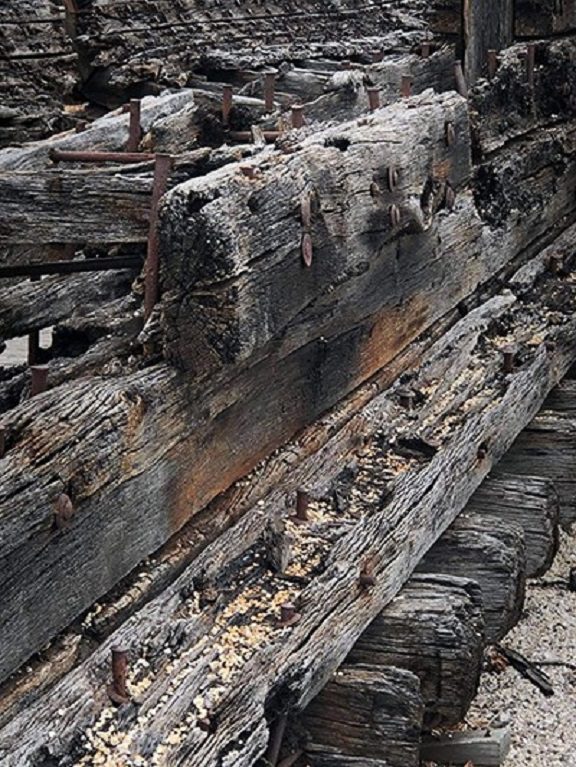
Close up of the LOTTIE COOPER’s timbers 2021 photo by Tina La Prest
Loaded with a cargo of elm wood, a severe gale prevented her from entering the Sheboygan Harbor the evening of April 8, 1894. She dropped anchor hoping for help the next morning. However, overnight she suffered serious damage, capsized, and sank before aid arrived April 9. Five crew members were saved, but one man drowned while trying to reach shore on a raft of planks. The hull of the ship drifted toward the shore, was abandoned by her owners, and the lake reclaimed her.
Covered by silt at the bottom of the lake until, in 1990, the wreck was discovered while the harbor was studied in preparation for construction of the Sheboygan Harbor Center Marina. In September 1992, the wreck was salvaged. Some of her reconstructed remains are on display south of Deland Beach.
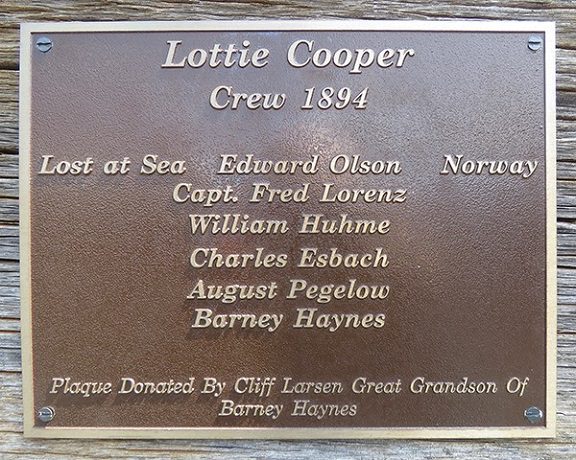
Plaque of the LOTTIE COOPER photo by Carl Eisenberg
Unlike wooden ships that sink in the ocean, wrecks in fresh water may last decades. Ocean wrecks do not stay intact long because of Teredo shipworms. When shipworms bore into submerged wood, bacteria (Teredinibacter turnerae) in a special organ called the Deshayes gland digest the cellulose exposed in the fine particles created by the excavation, according to the International Journal of Systematic and Evolutionary Microbiology.
Teredos are salt water creatures not found in fresh water. A wooden ship can last a long time submerged in fresh water. However, once it is taken out of the fresh water, the wood dries out and the relic is destroyed unless steps are taken to preserve the wood.
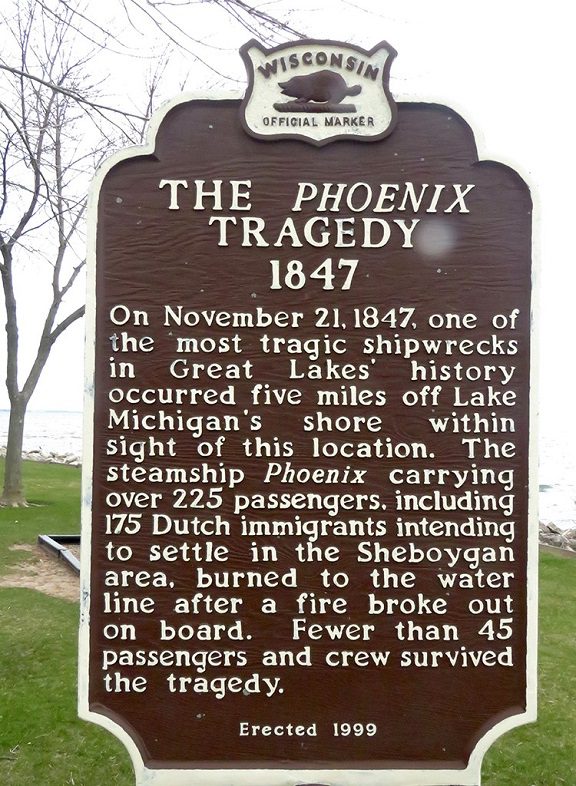
Plaque for the PHOENIX Tragedy photo by Carl Eisenberg
A bit farther north on Broughton Drive is a Wisconsin Maritime Trails Historic Shipwreck Marker that tells the harrowing story of a fire on the PHOENIX that burned the ship to the waterline in 1847 with a great loss of life.
In the early 1950s, when I was about 10, my father and I were on a small outboard fishing boat when a relative noticed that the motor had run out of gasoline. He decided to pour fuel into the hot engine while we were perhaps 100 feet from shore.
Immediately fire erupted at the stern of the boat. With my life jacket on, my father grabbed me, threw me into the water, and told me to swim to shore. I was oblivious to the danger. However, my mother, who was watching from the shore, knew well what might happen. I made it to shore unscathed, but this scary adventure led to my lifelong respect for the potential dangers of boating. Needless to say, I prefer sailboats now.
Thinking about what happened to the PHOENIX and what choices the people on board that burning ship must have endured creates an indelible image of what might have been.
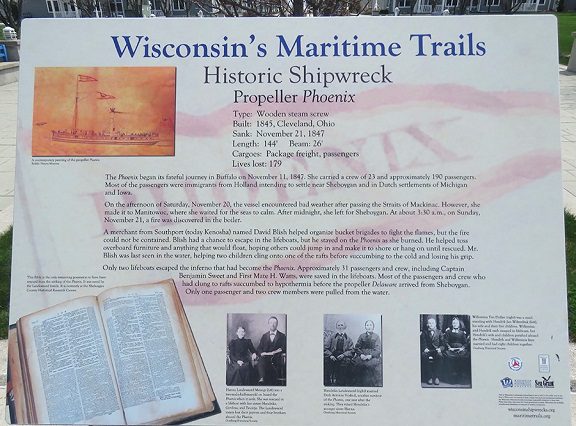
Wisconsin’s Maritime Trails marker for the PHOENIX photo by Carl Eisenberg
Built in Ohio in 1845, the PHOENIX was a 140.5-foot long wooden ship with a twin propeller and a single mast with auxiliary sails. The propeller had been invented only two years earlier. The estimated number of passengers was 186 with a complement of 23 officers and crew. Record keeping was poor at that time and more passengers may have boarded the PHOENIX at her home port of Cleveland and later Detroit. Many of the passengers were from Holland who were planning to settle in Wisconsin.
On November 11, 1847, the fire spread quickly from the engine room, eventually engulfing the entire ship, burning it to the waterline. Some people survived in one of the only three life boats carried by the PHOENIX. Many passengers died in the fire or in the cold Lake Michigan water. The steamer DELAWARE arrived from Sheboygan too late to help with rescues but towed the PHOENIX’s smoldering hulk toward the Sheboygan harbor. The wreck today lies north of the Sheboygan City boat ramp in eight feet of water but the wreckage is scattered over a large distance.
Farther north on Broughton Drive is the Maritime Trails Marker for Wisconsin’s oldest known shipwreck, the 95-foot, two-masted, wooden schooner, the GALLINIPPER.
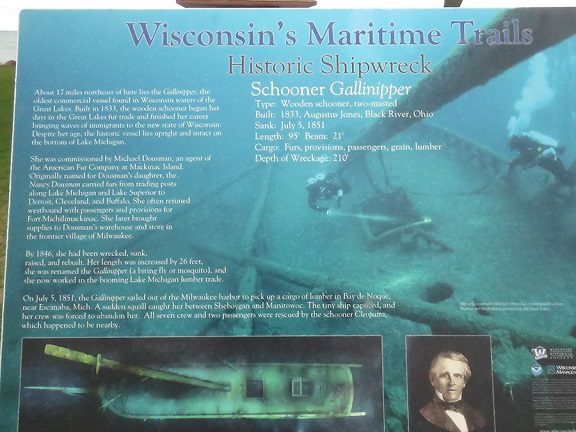
Wisconsin’s Maritime Trails marker for the GALLINIPPER photo by Carl Eisenberg
The GALLINIPPER was built in 1833 in Black River, Ohio, for Michael Dousman of Mackinac, then in what was called Michigan Territory, and named NANCY DOUSMAN. Her home port was Chicago. Her routine was to carry supplies to the Wisconsin frontier and return to eastern markets with fur pelts.
With a series of owners and wrecks, she was enlarged to carry more cargo, renamed the GALLINIPPER, and then moved the lumber out of Milwaukee. Subsequently, after changing owners and experiencing adverse events in 1848, 1850, and in May 1851, she sank at the mouth of the Milwaukee River. On July 7, 1851, sailing between Sheboygan and Manitowoc, about eight to ten miles from shore, she capsized twice in sudden high winds. Filling with water, she floundered. Her crew of six, two passengers, and Captain Henderson were rescued by a passing schooner, the CLEOPATRA. The GALLINIPPER did not sink immediately and was subsequently seen two more times with the last sighting being ten miles southeast of Manitowoc.
The sunken wreck of the GALLINIPPER was located in 210 feet of water in 1994. In 2009 a Wisconsin Historical Society archaeological survey led to the GALLINIPPER being put on the National Register of Historic Places in December, 2010.
———————————————————
Carl Eisenberg is a sailor and birdwatcher, and was president of the Wisconsin Marine Historical Society from 2016 to 2024. A retired pediatrician, he is a graduate of Duke University School of Medicine. He lives in Mequon, Wis.
Source material
National Library of Medicine: “Teredinibacter turnerae gen. nov., sp. nov., a dinitrogen-fixing, cellulolytic, endosymbiotic gamma-proteobacterium isolated from the gills of wood-boring molluscs (Bivalvia: Teredinidae)”; International Journal of Systematic and Evolutionary Microbiology.
https://pubmed.ncbi.nlm.nih.gov/12508896/
Wisconsin Shipwrecks, Phoenix (1845)
https://wisconsinshipwrecks.org/Vessel/Details/505?region=Index
Wisconsin Shipwrecks, Gallinipper (1832)
https://wisconsinshipwrecks.org/Vessel/Details/230?region=Index
Wisconsin Shipwrecks
https://wisconsinshipwrecks.org/Home#anchor3

